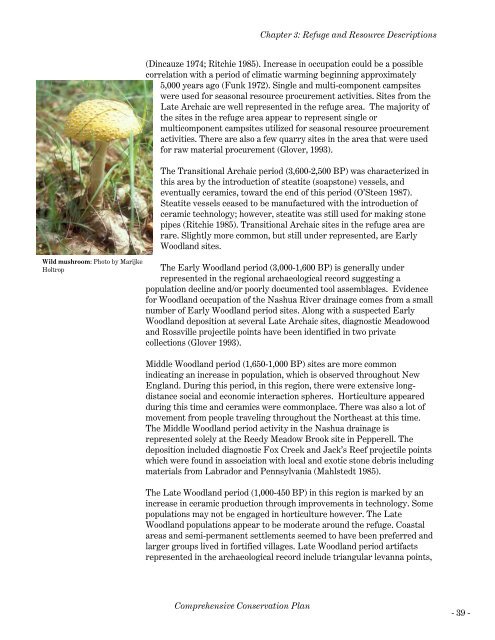Oxbow NWR Final CCP - U.S. Fish and Wildlife Service
Oxbow NWR Final CCP - U.S. Fish and Wildlife Service
Oxbow NWR Final CCP - U.S. Fish and Wildlife Service
You also want an ePaper? Increase the reach of your titles
YUMPU automatically turns print PDFs into web optimized ePapers that Google loves.
Chapter 3: Refuge <strong>and</strong> Resource Descriptions<br />
(Dincauze 1974; Ritchie 1985). Increase in occupation could be a possible<br />
correlation<br />
with a period of climatic warming beginning approximately<br />
5,000 years ago (Funk 1972). Single <strong>and</strong> multi-component campsites<br />
were used for seasonal resource procurement activities. Sites from the<br />
Late Archaic are well represented in the refuge area. The majority of<br />
the sites in the refuge area appear to represent single or<br />
multicomponent campsites utilized for seasonal resource procurement<br />
activities. There are also a few quarry sites in the area that were used<br />
for raw material procurement (Glover, 1993).<br />
The Transitional Archaic period (3,600-2,500 BP) was characterized in<br />
this area by the introduction of steatite (soapstone) vessels, <strong>and</strong><br />
eventually ceramics, toward the end of this period (O’Steen 1987).<br />
Steatite vessels ceased to be manufactured with the introduction of<br />
ceramic technology; however, steatite was still used for making stone<br />
pipes (Ritchie 1985). Transitional Archaic sites in the refuge area are<br />
rare. Slightly more common, but still under represented, are Early<br />
Woodl<strong>and</strong> sites.<br />
Wild mushroom: Photo by Marijke<br />
Holtrop<br />
The Early Woodl<strong>and</strong> period (3,000-1,600 BP) is generally under<br />
represented in the regional archaeological record suggesting a<br />
population decline <strong>and</strong>/or poorly documented tool assemblages. Evidence<br />
for Woodl<strong>and</strong> occupation of the Nashua River drainage comes from a small<br />
number of Early Woodl<strong>and</strong> period sites. Along with a suspected Early<br />
Woodl<strong>and</strong> deposition at several Late Archaic sites, diagnostic Meadowood<br />
<strong>and</strong> Rossville projectile points have been identified in two private<br />
collections (Glover 1993).<br />
Middle Woodl<strong>and</strong> period (1,650-1,000 BP) sites are more common<br />
indicating an increase in population, which is observed throughout New<br />
Engl<strong>and</strong>. During this period, in this region, there were extensive longdistance<br />
social <strong>and</strong> economic interaction spheres. Horticulture appeared<br />
during this time <strong>and</strong> ceramics were commonplace. There was also a lot of<br />
movement from people traveling throughout the Northeast at this time.<br />
The Middle Woodl<strong>and</strong> period activity in the Nashua drainage is<br />
represented solely at the Reedy Meadow Brook site in Pepperell. The<br />
deposition included diagnostic Fox Creek <strong>and</strong> Jack’s Reef projectile points<br />
which were found in association with local <strong>and</strong> exotic stone debris including<br />
materials from Labrador <strong>and</strong> Pennsylvania (Mahlstedt 1985).<br />
The Late Woodl<strong>and</strong> period (1,000-450 BP) in this region is marked by an<br />
increase in ceramic production through improvements in technology. Some<br />
populations may not be engaged in horticulture however. The Late<br />
Woodl<strong>and</strong> populations appear to be moderate around the refuge. Coastal<br />
areas <strong>and</strong> semi-permanent settlements seemed to have been preferred <strong>and</strong><br />
larger groups lived in fortified villages. Late Woodl<strong>and</strong> period artifacts<br />
represented in the archaeological record include triangular levanna points,<br />
Comprehensive Conservation Plan<br />
- 39 -

















